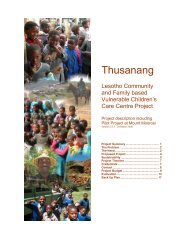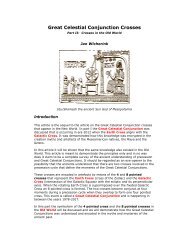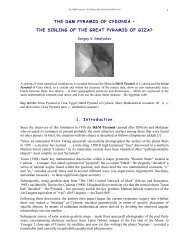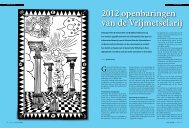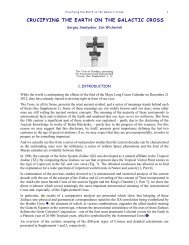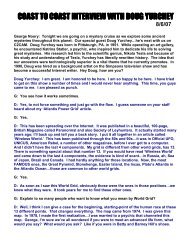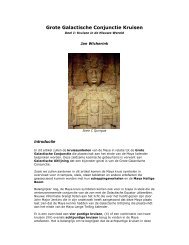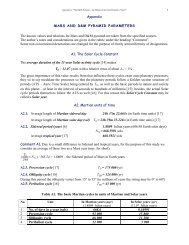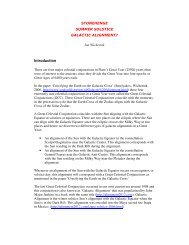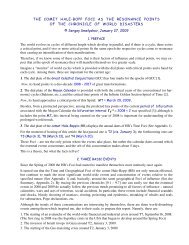Get a FREE Sampler PDF - Atlantis Rising Magazine
Get a FREE Sampler PDF - Atlantis Rising Magazine
Get a FREE Sampler PDF - Atlantis Rising Magazine
You also want an ePaper? Increase the reach of your titles
YUMPU automatically turns print PDFs into web optimized ePapers that Google loves.
ALTERNATIVE SCIENCE<br />
GLOBAL COOLING<br />
Is Mars Sending Us<br />
a Message about<br />
Planetary Geriatrics?<br />
• BY SUSAN MARTINEZ, Ph.D.<br />
Artist’s rendering of the Phoenix<br />
Lander on the arctic plains of Mars.<br />
(Art by Corby Waste, Jet Propulsion<br />
Laboratory, NASA)<br />
“….the earth and the heavens … all shall<br />
wax old as doth a garment.”<br />
Hebrews 1:10-11<br />
With great expectations hinging<br />
on NASA’s latest exploration of<br />
Mars—the Phoenix lander<br />
touching down smoothly on the<br />
Red Planet’s northern ice plains in May—<br />
scientists are holding their breath for signs<br />
of ancient water and life on that barren<br />
world. Could success for the $457 milliondollar<br />
mission—the first to study Mars’<br />
arctic plains—depend on finding, under<br />
polar ice, organic chemicals or perhaps<br />
“nanofossils”?<br />
Back in ’04 when Mars was last making<br />
news, NASA having landed a rover on the Red<br />
Planet, one MIT engineering student floated<br />
the idea of “terraforming” Mars by melting<br />
her polar caps to make her warm, wet and<br />
habitable once again. The quixotic sci-fi<br />
scheme reminds one of those miraculous<br />
wrinkle creams that inevitably pop up when<br />
you go online. Most of us, though, will have<br />
to settle for growing old gracefully and getting<br />
a laugh out of the latest crackpot<br />
scheme to reverse aging or bring the dead<br />
back to life. In such matters, I think of the<br />
eternal truth of Hindu theology which posits<br />
a holy trinity composed of Brahma, Vishnu,<br />
and Shiva. These great deities in turn resolve<br />
into creator, sustainer, destroyer. And finally<br />
they represent birth, life, and death.<br />
If planets are living things, they too, it<br />
seems, must have a natural lifespan, ending<br />
inexorably in dust and decay. But Western<br />
science and sensibility, enamored of unlimited<br />
growth, has been loathe to admit death<br />
and dissolution. Indeed, when the first dinosaurs<br />
were exhumed early in the nineteenth<br />
century, the very idea of extinction of species<br />
was not only brand new, it was repugnant. It<br />
was horrible. “It is contrary to the common<br />
course of providence to suffer any of his<br />
creatures to be annihilated,” said Quaker<br />
naturalist P. Collinson.<br />
At the time of the first dinosaur discovery,<br />
the world of extinct life was an unknown,<br />
still buried in the past. “Geologic<br />
time,” as it is called, was just being discovered.<br />
Although the first dinosaur (“the Great<br />
Fossil Lizard of Stonesfield” at Sussex, UK,<br />
1822) was much celebrated, the “overgrown<br />
lizard” triggered instant debate and controversy.<br />
How could a species have vanished<br />
from the good earth? Soon it would be<br />
known that “a staggering number” of other<br />
creatures, as well as plants, sang their death<br />
song to the dawning tertiary.<br />
Shiva, or the “destroyer,” as the ancient<br />
world dubbed the force-pulling-down, was<br />
nothing sinister (quite the contrary), but<br />
simply the inevitable vanishment or dissolution<br />
of all material substance. And while the<br />
sages of old knew all about the birth and<br />
death of worlds once they fulfilled their<br />
labor, we moderns seem to have forgotten<br />
that all stories have a beginning, middle and<br />
end; instead, our “sages” would inject the<br />
patently geriatric Red Planet with their version<br />
of new life; or would interpret her moribund<br />
frigidity (-40 degrees F. on a typical<br />
summer’s day) as the result of being “currently<br />
in the grip of an ice age;” or would account<br />
for her Stygian, tomblike “drought” as<br />
“some change in the planet’s atmosphere…causing<br />
water to vaporize…” Or titillate<br />
the mind with recondite (and so far inconclusive)<br />
studies into “possible life on<br />
Mars.”<br />
The Red Planet, well into her dotage, is<br />
not a potential piece of real estate, nor is it<br />
likely to be making a comeback any time<br />
soon. She will, in all likelihood, get only<br />
colder and drier.<br />
She’s history, it appears.<br />
Neither is our Mother Earth, Mars’ “sister<br />
planet,” a youngster. Three things are seen to<br />
happen in the life of a world—any world.<br />
Slowing, drying, and cooling, from day one.<br />
The proto-world, we are told, began as a<br />
seething ball of liquid fire, boiling and<br />
roiling, whirling and swirling. She was still a<br />
twisting turbulent vortex of friction, gas<br />
clouds in rapid rotation slowly but surely<br />
condensing particles in solution. It would<br />
take, the argument goes, almost a billion<br />
years for the newborn world to produce the<br />
first shred of life. The molten earth, after all,<br />
before we can go for a walk in the park, must<br />
turn down the lights, slow down, cool down,<br />
46 ATLANTIS RISING • Number 71 Subscribe or Order Books, DVDs and Much More!



